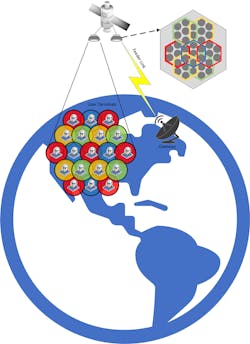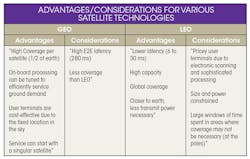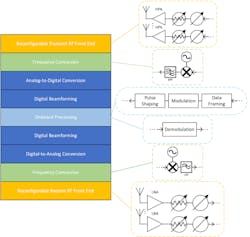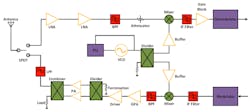Non-Terrestrial 5G: The Growing Role of Satellites and the mmWave Infrastructure
Download this article in PDF format.
Next-generation wireless infrastructure will leverage millimeter-wave (mmWave) spectrum to enable the large data rates necessary to meet 5G’s key performance indicators (KPI). Not only is this spectrum leveraged for the terrestrial network, but also in space by utilizing current (and future) satellite installations in the Ka-band (and beyond) to supplement 5G.
Set for delivery in 2021, the 3rd Generation Partnership Project’s (3GPP) Release 17 will introduce several use cases for the 5G satellite network that include the various satellite technologies available with geostationary-orbiting (GEO), medium-earth-orbiting (MEO), and newer low-earth-orbiting (LEO) satellites. The satellite-communications (SATCOM) industry is already putting vast amounts of R&D into developing seamless integration of 5G platforms with network virtualization; this integration affects the entire satellite infrastructure from the ground segment to the space segment.
GEO, HTS, and LEO Smallsat Constellations
The typical satellite-network architecture involves a mobile uplink/downlink—the communications between the satellite and the end users—as well as a feeder uplink/downlink, or, the channels between the satellite and the ground station/gateway that’s connected to the terrestrial data network. Traditional fixed satellite service (FSS) involves large GEO satellites that service swaths of land as vast as continents with only a few beams to few user terminals. This means less power and less effective throughput for an allocated geographical area than the newer high-throughput satellite (HTS) technology.
As shown in Figure 1, an HTS combines multiple spot beams and frequency reuse to achieve more precise beams that cover a smaller, more confined area of the planet. This has resulted in much larger throughput capabilities (on the order of hundreds of gigabits per second). Soon, these satellites will achieve terabit capacities by moving up the spectrum even further from the Ka-band to the Q/V-bands for thousands of spot beams.
LEO constellations comprise an array of small satellites and ground stations that can inter-communicate with ground-to-ground station (G2G) links, satellite-to-satellite (S2S) links, ground-to-satellite (G2S) links, and satellite-to-ground (S2G) links. The LEO constellations have the massive benefit of much lower latency; a GEO satellite orbiting at 35,000 km has an end-to-end delay at 280 ms, while a LEO satellite orbiting at 350 to 1,200 km drops that delay down to 6 to 30 ms, respectively.
Much of the enabling technology behind realizing seamless LEO connectivity falls upon the ability of the user terminals to perform handoffs between satellites. The table briefly lists some of the advantages and considerations of each of these satellite technologies. The current HTS satellite installations could help supplement the 5G terrestrial network in the use cases listed by 3GPP and the SaT5G project that’s spearheaded by the European Union (EU). In the future, the LEO infrastructure can add more latency-sensitive 5G applications into the mix.
Transparent vs. Regenerative Payload
Much of the 3GPP study on satellite integration into the 5G network involves the use of a regenerative payload within the satellite, allowing it to be a distributed unit (DU), or even a full gNB (5G base station) supporting a satellite-enabled new radio, radio access network (NR-RAN). The more traditional, transparent payload technology simply “mirrors” received signals and transmits only an amplified version of the signal with frequency conversion from uplink to downlink frequencies.
As with a typical transceiver, after filtering, the received signal is amplified with an LNA and frequency-converted by a mixer. The received signal is then amplified through an on-board high-power amplifier (HPA) and delivered through the transmitting antenna back to the ground station.
As alluded to by its name, the regenerative payload “regenerates” incoming signals with signal-processing techniques such as demodulation, decoding, switching, encoding, and modulation before transmitting for more precise division of spectrum. This can remove the attenuation effects in the uplink before downlinking to user terminals, with potential benefits such as mitigating the risk of an intermittent signal or downtime during rainfall.
A regenerative payload is possible with on-board processing (OBP) that’s either a digital transparent processor (DTP) or a fully regenerative (FR) transponder. When FR transponders include advanced functionalities such as encoding/decoding, the DTP transponder can enhance signal performance with efficient routing or increase spectral efficiency of the feeder link. The OBP is placed between the LNA and the HPA to convert the air interface between the uplink and the downlink.
Inter-satellite links (ISLs) in LEO constellations can be used for communications between regenerative payloads. This widens the geographical scope of the receiving ground station/user terminal. The mesh network between satellites in a constellation can provide great utility in supplementing a limited terrestrial-based 5G infrastructure.
Several feasible satellite architectures could be integrated with the terrestrial 5G network, depending on the type of payload used (Fig. 2). A transparent payload will function as an RF remote unit, transmitting signals from a ground-based RRU and gNB. A regenerative payload can function either as a DU with some NR processing capabilities or as a fully functional gNB.
Broad Use-Case Categories
According to 3GPP TR 22.822, there are three main use cases for satellite integration in 5G: service scalability, service ubiquity, and service continuity. These use cases also directly correlate with the four use cases presented by the EU’s SaT5G project:
- Fixed backhaul for hard-to-reach areas
- Complementary service for underserved areas
- Complementary broadband connectivity at the edge
- Moving platforms
By moving between the terrestrial and satellite networks, service continuity can be obtained with moving user equipment (UE) located in mobile platforms such as a car, truck, train, airplane (commercial or private), or ship. Figure 3 lists the examples used in the 3GPP TR 22.822 for each of these broad use cases.
Service ubiquity involves providing cellular access to “underserved” areas, or to areas in which the entire infrastructure could be shut down by a natural disaster. While this includes service to residences in rural areas, it can also involve applications that reside in underserved areas such as public safety/emergency networks as well as commercial/industrial IoT applications covering a large geographical area (e.g., smart agriculture; oil and gas pipelines/asset tracking).
Satellite scalability directly intends to take advantage of satellites’ inherent multicasting capability. Because the coverage area of a satellite is large, the channel codes (e.g., DVB-S2X) used are long to overcome noise effects. This way, a singular code word contains information sent from multiple users. Similarly, the coded frame transmitted by the satellite also is decoded by the group of users creating a multicast transmission. A message doesn’t have to be sent hundreds of times to hundreds of users. Rather, it can be sent once to a number of users, making multicast transmission ideal for rich TV content (e.g. 3D, UHD).
The Satellite and Ground-Station Signal Chain
While significant technological advances are occurring within the satellite, the ground station and user terminals also carry much of the R&D burden to be compatible with 5G. Much of this relies on the data processing in the gateway, while the RF front end must function at several carrier frequencies at 1.5 GHz, 2 GHz, 20 GHz (DL), 30 GHz (UL), and finally 40 to 50 GHz. Newer satellites in both HTS and LEO constellations are outfitted almost exclusively with Ku- and Ka-band transponders—falling right at the lower end of the millimeter-wave spectrum.
Within the satellite, the software-defined payload can leverage multi-beam antennas in an array-fed reflector or direct-radiating array configuration with digital beamforming (Fig. 4). This delivers more agile power and frequency allocation per beam as well as flexible frequency reuse and coverage.
In the ground segment, it takes high transmit power levels for a signal to traverse the required distances and overcome attenuation effects. The block diagram shown in Figure 5 shows the RF signal processing required for a user terminal or very small aperture terminal (VSAT). Precision coaxial and waveguide components are often required in both the ground and space segments. The antenna of choice can range between reflector (parabolic/dish) or an electronically scanning flat antenna such as phased array.
Conclusion
The growing satellite infrastructure is poised to supplement the ever-growing 5G ground infrastructure with viable, high-capacity services. This integration is underway with projects such as SaT5G as well as more standardization in 3GPP Release 17 for 2021. The mmWave spectrum not only offers the terrestrial 5G network with a relative abundance of bandwidth, but also the non-terrestrial 5G network with the addition of spot beams that have more flexible frequency reuse schemes for HTS technologies. Moreover, onboard processing allows for satellites to function not only as RF remote units, but also as DUs for more complex 5G XHaul.
LEO constellations open up the feasible applications in more latency-constrained venues such as automated factories. The regenerative payloads in some LEO constellations and HTS can also function as a gNB, opening up avenues to provide access to connect UE globally. The inter-satellite links of LEO constellations can seamlessly connect UE in scattered geographical locations. This has powerful implications for industrial/agricultural IoT as pockets of devices covering large swathes of land for monitoring/tracing purposes can be wirelessly tracked in a unified fashion. The growing demands for higher capacity, shorter latency, and processing power calls for use of high-quality, capable components within the signal chain.
Peter McNeil is a Marketing Manager at Pasternack.
References
1. “Study on using satellite access in 5G,” TR 22.822 V16.0.0, Jun. 2018.
2. “Study on management and orchestration aspects with integrated satellite components in a 5G network”, TR 28.808 V0.4.0, Nov. 2019.
About the Author
Peter McNeil
Marketing Manager, Pasternack
Peter McNeil is a marketing manager at Pasternack and has over 25 years of experience in sales development, product management, and marketing in the telecommunications, RF, and microwave industries. He currently oversees the development and delivery of several of Infinite Electronics brands content, including Pasternack.



![2. Shown are satellite architectures for 5G integration in 3GPP TR 28.808 with a traditional satellite topology (a). The transparent payload mirrors NR signals generated from a ground gNB (b). In a regenerative payload (c), some NR protocols are processed by the satellite, whereas in (d), the regenerative payload functions as a standalone gNB fully supporting NR protocols [2]. (Credit: 3GPP) 2. Shown are satellite architectures for 5G integration in 3GPP TR 28.808 with a traditional satellite topology (a). The transparent payload mirrors NR signals generated from a ground gNB (b). In a regenerative payload (c), some NR protocols are processed by the satellite, whereas in (d), the regenerative payload functions as a standalone gNB fully supporting NR protocols [2]. (Credit: 3GPP)](https://img.mwrf.com/files/base/ebm/mwrf/image/2020/05/Pasternack_5G_Figure_2.5ec81b93ab840.png?auto=format,compress&fit=max&q=45?w=250&width=250)
![3. Shown are examples for each use case listed in 3GPP TR 22.822 [1]. 3. Shown are examples for each use case listed in 3GPP TR 22.822 [1].](https://img.mwrf.com/files/base/ebm/mwrf/image/2020/05/Pasternack_5G_Figure_3.5ec81bb2b385a.png?auto=format,compress&fit=max&q=45?w=250&width=250)

